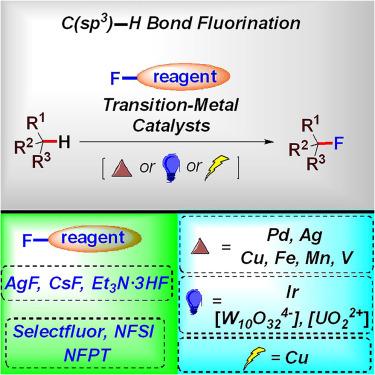Chem Catalysis ( IF 11.5 ) Pub Date : 2024-06-06 , DOI: 10.1016/j.checat.2024.101009 Robbie Ge , Ziting Xu , Ke Yang , Haibo Ge

|
Constructing C−F bonds via C−H activation has been a subject of considerable attention in the field of organic synthesis. Within this reaction class, the popularity of transition-metal-catalyzed approaches has substantially expanded in recent years. Currently, there are two main types of these reaction pathways. The first type involves the formation of a carbon-metal-fluorine intermediate with the assistance of a directing group. The second type utilizes a transition metal species to generate a radical or carbocation intermediate. Despite the importance of these reactions, there has yet to be a comprehensive review of transition-metal-catalyzed C(sp3)−H bond fluorination processes. This review presents major advances in and detailed mechanistic discussions of transition-metal-catalyzed C(sp3)−H bond fluorination reactions with different reaction modes under various thermal, photochemical, and electrochemical conditions.
中文翻译:

过渡金属催化的C(sp3)–H键氟化反应
通过CH活化构建CF键一直是有机合成领域备受关注的课题。在这一反应类别中,过渡金属催化方法的普及近年来已大大扩展。目前,这些反应途径主要有两种类型。第一种类型涉及在导向基团的帮助下形成碳-金属-氟中间体。第二种类型利用过渡金属物质来产生自由基或碳正离子中间体。尽管这些反应很重要,但尚未对过渡金属催化的 C(sp 3 )−H 键氟化过程进行全面综述。该综述介绍了过渡金属催化的 C(sp 3 )−H 键氟化反应在各种热、光化学和电化学条件下以不同反应模式进行的主要进展和详细的机理讨论。






































 京公网安备 11010802027423号
京公网安备 11010802027423号